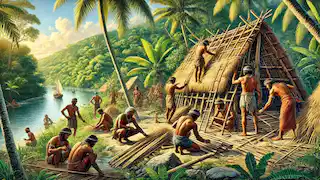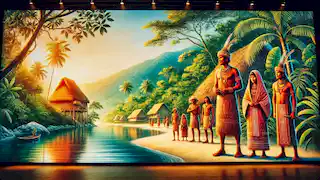The Caribbean, a region celebrated today for its vibrant culture, tropical climate, and sparkling seas, was once the thriving home of the Arawak people, an indigenous civilization that lived in harmony with nature long before European explorers set foot on these islands. This is the story of their origins, traditions, struggles, and the legacy they left behind.
The Arawak people, also known as the Taíno, were the first to greet Christopher Columbus upon his arrival in the New World in 1492. They inhabited the Greater Antilles, including present-day Cuba, Jamaica, Hispaniola (Haiti and the Dominican Republic), and Puerto Rico, as well as the Bahamas and parts of the Lesser Antilles. Their story is a testament to resilience, innovation, and the delicate balance between humanity and nature. The origins of the Arawak people can be traced back to the Orinoco River Basin in South America, where they embarked on an epic journey across the Caribbean Sea over 2,000 years ago. Navigating treacherous waters in their sturdy canoes, they gradually settled on various islands, attracted by the rich, fertile lands and abundant marine life. The Arawaks were skilled farmers, fishermen, and artisans. They brought with them seeds of cassava, sweet potatoes, corn, peanuts, and cotton, which they planted to sustain their communities. Their settlements were typically located near rivers and coastal areas, where they built thatched-roof houses called "bohíos" made from palm leaves and wood. The largest communities were centered around communal buildings known as "caney," which served as meeting halls and ceremonial spaces. The society of the Arawak people was organized, peaceful, and structured. They were led by chiefs known as "caciques," who governed with the help of priests and advisors. The cacique's role extended beyond politics; they were also responsible for ensuring that the people lived in harmony with nature, honoring the spirits of the land, sea, and sky. The Arawak culture was rich in oral traditions, storytelling, and spiritual beliefs. They worshipped a pantheon of gods and spirits, known as "zemis," which represented natural elements like the sun, rain, wind, and the sea. These zemis were believed to influence every aspect of life, from agriculture to health and prosperity. Each family had its own carved zemi idols made from wood, stone, or clay, which were placed in sacred spaces within their homes. The people adorned themselves with intricate jewelry made from shells, bones, and precious stones. They painted their bodies with natural dyes for ceremonies, battles, and special occasions, often using bright reds, yellows, and blacks to symbolize different aspects of their identity and beliefs. The Arawak people were expert craftsmen. Women wove cotton into hammocks and clothing, while men crafted tools, weapons, and ceremonial artifacts from wood, stone, and bone. They developed a distinctive pottery style, decorated with intricate patterns that depicted their environment and mythology. Music and dance were essential components of Arawak life. They played instruments such as flutes, drums, and rattles during celebrations and religious ceremonies. The dances, often held under the moonlight, were a means of storytelling, paying homage to ancestors, and invoking blessings from the zemis. The Arawak people were skilled farmers, cultivating crops like cassava, yams, beans, peppers, and tobacco. They used slash-and-burn techniques to clear the land, ensuring that the soil remained fertile. Their staple food, cassava, was ground into flour and made into bread, providing a reliable source of sustenance. Fishing was another critical aspect of their diet, and the Arawaks expertly crafted nets, traps, and spears to catch fish, crustaceans, and other marine life. The coastal waters provided a bountiful harvest, supplementing their agricultural produce and ensuring a balanced diet. Trade was a vital aspect of Arawak society. They engaged in extensive trade networks with neighboring islands and mainland communities, exchanging goods such as pottery, cotton, cassava bread, and exotic feathers. This exchange of resources and ideas fostered a sense of unity among the various indigenous peoples of the Caribbean, allowing for the sharing of knowledge, techniques, and cultural practices. The arrival of Christopher Columbus in 1492 marked a turning point in the history of the Arawak people. Initially, the Arawaks greeted the Europeans with hospitality, offering food, water, and shelter. They marveled at the strange clothing, weapons, and ships of the newcomers, unaware of the impending dangers that would soon threaten their way of life. Columbus, driven by his quest for gold and wealth, quickly exploited the generosity of the Arawaks. The Europeans noted the gold ornaments worn by the people and demanded to know the source. Despite the Arawak's attempts to explain that their land was not rich in gold, the Spaniards became increasingly aggressive in their pursuit of wealth. The Spaniards enslaved many Arawaks, forcing them to mine for gold, work on plantations, and perform laborious tasks. Those who resisted were met with violence, and entire communities were devastated by the brutality of the colonizers. The Arawaks, who had never encountered such cruelty, struggled to defend themselves against the superior weaponry and military tactics of the Europeans. In addition to the violence and enslavement, the Arawak people faced a new, invisible threat: diseases brought by the Europeans. Smallpox, influenza, and measles spread rapidly through their communities, decimating the population, as they had no immunity to these foreign illnesses. Entire villages were wiped out within a matter of months, leaving behind only memories of the vibrant society that once thrived in the Caribbean. Despite the overwhelming odds, the Arawak people did not surrender without a fight. Caciques such as Hatuey, Anacaona, and Guarionex led rebellions against the Spanish invaders, rallying their people to defend their lands, families, and way of life. These acts of resistance, though ultimately unsuccessful, demonstrated the resilience and courage of the Arawak people in the face of unimaginable adversity. By the early 16th century, the population of the Arawak people had dwindled dramatically. The combined impact of warfare, disease, and enslavement led to their near extinction in the Caribbean. However, their legacy endured, woven into the fabric of Caribbean culture, language, and traditions. Today, words from the Arawak language, such as "canoe," "hammock," and "barbecue," are still used, serving as a reminder of their influence. Their agricultural practices, particularly the cultivation of cassava and sweet potatoes, continue to be a staple in Caribbean cuisine. The Arawak's craftsmanship, pottery, and artistic expressions have inspired generations of artisans, and their stories and mythology are passed down through oral traditions. In recent years, there has been a resurgence of interest in the history and culture of the Arawak people. Archaeologists, historians, and descendants have worked tirelessly to uncover artifacts, decipher oral histories, and preserve the remnants of this once-great civilization. Museums and cultural centers across the Caribbean now celebrate the contributions of the Arawak people, ensuring that their story is not forgotten. Educational programs have been established to teach the younger generations about the Arawak way of life, fostering a sense of pride in their indigenous heritage. Festivals, reenactments, and cultural exchanges honor the Arawak's contributions, allowing people from all walks of life to experience their rich traditions. The story of the Arawak people serves as a powerful reminder of the importance of preserving indigenous cultures, respecting nature, and understanding the consequences of unchecked greed and exploitation. Their harmonious relationship with the environment, sustainable agricultural practices, and emphasis on community and spirituality offer valuable lessons for the modern world. As we reflect on the history of the Arawak people, we are reminded that they were not merely victims of colonization but a resilient and adaptive civilization that left an indelible mark on the Caribbean. Their spirit lives on in the music, dance, art, and traditions that continue to shape the identity of the islands they once called home. The Arawak people were pioneers, artists, warriors, and caretakers of the land. Their legacy endures in the hearts and minds of the Caribbean people, who continue to celebrate their heritage through art, music, language, and the preservation of their history. The story of the Arawak people is a testament to the enduring human spirit and the power of resilience, a reminder that even in the face of adversity, the legacy of a people can live on for generations.Origins and Settlement

Culture, Beliefs, and Daily Life
Trade, Agriculture, and Sustainable Living
Encounter with the Europeans

The Impact of Disease and Struggle for Survival
The Decline and Legacy of the Arawak People

Rediscovering the Arawak Heritage
Lessons from the Past
Conclusion


















